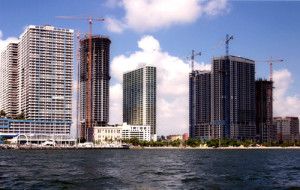Increased Costs Shifting South Florida Apartment Construction
 At the Miami Finance Forum’s recent panel discussion regarding the current status of South Florida commercial real estate, panelist commercial developers stated they are responding to strong tenant demand across all sectors. While all agree that the South Florida commercial real estate market, and especially multifamily rental, has appreciated substantially since the recession, the debate among experts centers around the question of whether the market has peaked, or still has some runway. The response to this question varies by expert and can be segmented into particular asset subclasses or geographic submarkets. Notwithstanding, no panelist categorized the market as recessionary. Instead, they view the market as a stable plateau after sustained significant year-over-year appreciation.
At the Miami Finance Forum’s recent panel discussion regarding the current status of South Florida commercial real estate, panelist commercial developers stated they are responding to strong tenant demand across all sectors. While all agree that the South Florida commercial real estate market, and especially multifamily rental, has appreciated substantially since the recession, the debate among experts centers around the question of whether the market has peaked, or still has some runway. The response to this question varies by expert and can be segmented into particular asset subclasses or geographic submarkets. Notwithstanding, no panelist categorized the market as recessionary. Instead, they view the market as a stable plateau after sustained significant year-over-year appreciation.
A large portion of the discussion focused on multifamily rentals. In regards to multifamily, the market drivers for apartments are at opposite ends of the generational spectrum. Apartment-development flow continues to be driven by two demographic sectors. The first are millennials, who in the post-recession environment face a credit crunch and cannot afford to yet achieve their dreams of suburbia. In addition to millennials, baby boomers are also driving the market as they no longer want the hassle of maintaining a home.
Apartment development is also driven by investors seeking yield as prices continued to be buoyed by low interest financing from Freddie Mac and Fannie Mae. The combination of continued low interest financing from Freddie Mac and Fannie Mae in conjunction with millennial and baby boomer market drivers, has resulted in apartment construction numbers that will reach over 5,000 apartment units. These units are in the planned or under construction stage in the Miami Brickell and Downtown areas.
While this is a large number of apartments in the pipeline, experts believe this figure should now stabilize as project viability is hitting against the difficult realities of increased land and construction costs. For example, based on these increased land and construction costs, Brickell apartment projects are now require proforma rents of $3.50/SF, up from $2.75/SF, in order to meet target returns.
Even in suburban areas such as Kendall rental rates have for the first time pushed passed $1.00/SF. Jay Massirman, founder and managing principal of Rivergate Cos, shared his views on multifamily at the Miami Finance Forum panel discussion. Massirman stated, the core urban market is not the only one seeing significant apartment development. Increased land costs in the urban core have resulted in pushing development out to the suburbs. Projects have geographically expanded beyond only the urban scope. Additionally, investors hungry for yield have expanded beyond being limited to institutional investors. “Every available site across South Florida is being developed, and not just by institutional investors or REITS, but by also ultra high net worth individuals”, stated Massirman.
These factors of increased supply and costs unavoidably point to a cooling in new South Florida apartment construction. Massirman sees the apartment market, “at the top of the roller coaster with land prices in particular.” In terms of financing, Massirman also sees land prices peaking to the point where the lending community has pushed back, but still has some money to allocate for select projects and developers.
These increased costs not only have an effect on whether or not projects are built, but also the type of projects that are built. Notwithstanding, even with the continued development of apartment supply, the low-income sector continues to be greatly underserved. The situation is further exacerbated by the increased land and construction costs which make low income rental a less attractive proposition. Additionally, due to rising construction costs, rental units on average are becoming smaller and developers are focusing on buildings of eight floors or less if possible.
Ultimately, the current state of the market requires developers, investors and lenders to take a closer look at construction and land costs when evaluating projects. Emphasis must be had on the effects of these increased costs in the negotiation of both joint venture agreements and construction loan documents. Lastly, high focus should be placed on language regarding completion guarantees, cost overruns and contingency provisions in order to provide predictability to developers, investors and lenders in the face of an increasing cost environment.

